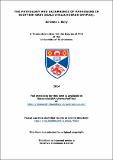Files in this item
The pathology and occurrence of pathogens in Scottish grey seals (Halichoerus grypus).
Item metadata
| dc.contributor.advisor | Hall, Ailsa Jane | |
| dc.contributor.advisor | Dagleish, Mark P. | |
| dc.contributor.author | Baily, Johanna L. | |
| dc.coverage.spatial | 381 | en_US |
| dc.date.accessioned | 2014-06-05T13:43:39Z | |
| dc.date.available | 2014-06-05T13:43:39Z | |
| dc.date.issued | 2014-06-25 | |
| dc.identifier | uk.bl.ethos.605821 | |
| dc.identifier.uri | https://hdl.handle.net/10023/4856 | |
| dc.description.abstract | Neonatal mortality in grey seals on the Isle of May breeding colony and in a rehabilitation centre were investigated by detailed systematic post-mortem examinations (n=59), on-site bacteriology and advanced molecular diagnostic techniques for specific pathogens. Causes of death on the breeding colony included starvation (30%), omphalitis-peritonitis (26%), septicaemia (22%), stillbirth (10%) and trauma (4%) and in the rehabilitation centre starvation (44%) and septicaemia (22%). Detailed key gross and histopathological findings and pathogens are described and include the first report of Listeria monocytogenes in any marine mammal. Phocid herpes virus 1 nucleic acids were detected in nasal swabs of 58% live, free-ranging grey seal pups (n=90) and 28% yearlings (n=19), suggesting recrudescence in the latter. Previously undetected in Scotland, phocid herpes virus 2 nucleic acids were identified only in yearlings (15%); sealpox was detected in a single live stranded grey seal pup and phocine distemper virus was not detected. Given their unique characteristics and potential for acting as sentinels of coastal marine health several pathogens of putative anthropogenic origin were investigated: Toxoplasma gondii, Neospora caninum, Salmonella spp. and Campylobacter spp. Toxoplasma gondii DNA was detected in 6% dead free-ranging grey seal pups (n=50) but N. caninum was not found. Salmonella (20%) and Campylobacter (50%) were isolated from rectal swabs of live and dead grey seal pups and Campylobacter was significantly associated with moderate to severe colitis implying pathogenicity. These findings imply a land-sea-land transfer of T. gondii and early exposure of pups to this parasite. Extensive genetic fingerprinting suggested an exchange of Salmonella between grey seal, cattle and human populations and that the Campylobacter isolates may share the same origin as human clinical isolates. This work provides a solid base line study of diseases present in grey seal pups and demonstrates that they are useful indicators of coastal marine microbial contamination. | en_US |
| dc.language.iso | en | en_US |
| dc.publisher | University of St Andrews | |
| dc.rights | Creative Commons Attribution-NonCommercial-NoDerivatives 4.0 International | |
| dc.rights.uri | http://creativecommons.org/licenses/by-nc-nd/4.0/ | |
| dc.subject | Grey seal | en_US |
| dc.subject | Halichoerus grypus | en_US |
| dc.subject | Pathology | en_US |
| dc.subject | Microbiology | en_US |
| dc.subject | Scotland | en_US |
| dc.subject | Sentinels | en_US |
| dc.subject | Salmonella | en_US |
| dc.subject | Campylobacter | en_US |
| dc.subject | Herpesvirus | en_US |
| dc.subject | Neonatal | en_US |
| dc.subject | Wildlife | en_US |
| dc.subject.lcc | QL737.P64B2 | en_US |
| dc.subject.lcsh | Gray seal--Pathogens--Scotland | en_US |
| dc.title | The pathology and occurrence of pathogens in Scottish grey seals (Halichoerus grypus). | en_US |
| dc.type | Thesis | en_US |
| dc.contributor.sponsor | Moredun Research Institute | en_US |
| dc.contributor.sponsor | Royal Zoological Society of Scotland | en_US |
| dc.type.qualificationlevel | Doctoral | en_US |
| dc.type.qualificationname | PhD Doctor of Philosophy | en_US |
| dc.publisher.institution | The University of St Andrews | en_US |
| dc.publisher.department | Moredun Research Institute | en_US |
This item appears in the following Collection(s)
Except where otherwise noted within the work, this item's licence for re-use is described as Creative Commons Attribution-NonCommercial-NoDerivatives 4.0 International
Items in the St Andrews Research Repository are protected by copyright, with all rights reserved, unless otherwise indicated.


